The Dynamic Change in the Reliability Function Level in a Selected Fire Alarm System during a Fire
Abstract
:1. Introduction
1.1. Application of Integrated FAS with Varying Functional Structures within SCI-Classified Facilities and Vast Areas
1.2. Fire Scenario and Its Implementation during Monitoring and Alarming—Ensuring the Reliability of Controls during a Fire
1.3. FAS and GES Power Supply during a Fire
2. Literature Review
2.1. Review of the Source Literature on ESS Diagnostics
2.2. Overview of Issues Related to Processes Associated with the Occurrence of Natural Environment Interference
2.3. Overview of Operational Issues Related to Power Supply
2.4. Overview of Issues Associated with the Operation of ESS Sensors—Detectors
3. The Application of Fire Alarm and Gas Extinguishing Systems in Critical Infrastructure Buildings and Over a Vast Area
4. The Impact of FCV on Elements and Systems Employed within FAS and GES
- inducing stresses in ESS component structures, e.g., detectors that involve materials with various expansion coefficients, e.g., glass (detector lens), metal (PCB board) or element soldering points (tin), etc.;
- decaying significant stresses due to the functioning of interface materials in the contacts, e.g., detector, assembly socket, NO and NC relay contacts;
- imparting reduced maximum load capacity of conductive materials, e.g., power cables, resistors, or active and passive elements;
- initiating gradual degradation—reducing value and properties of insulating materials, e.g., a temperature increase of 50 °C leads to an approx. 14-fold change in the surface resistivity of the glass–epoxy laminate applied in a PCB.
- Silicon power transistor joint temperature increasing by 10 °C leads to a doubled number of failures. All technical parameters of these elements are subject to change. This includes, e.g., hybrid parameters h11 to h22 or voltage UBE, etc.
- The parameters of passive elements within FCP PCB or detectors are modified. Failure rates double, e.g., in capacitors, upon a temperature increase of 15 °C, in resistors, 35 °C.
- Solder joint strength properties are also changed (reduced twofold) upon a temperature increase from room value (25 °C) to 70 °C.
4.1. Basic Technical Assumptions Regarding FAS and GES Operation Processes Associated with Modeling the Operation of These Systems
- Failure intensity λ for all ESS elements and devices is constant during operation, when there is not a fire, whereas a fire that breaks out causes a change in the failure intensity λ within the operation process. The λ value is always non-negative. All electronic, electric, and electromechanical elements and devices employed in FASs and GESs are subject to a so-called ‘pre-aging process’ at their manufacturing plants. The duration and implementation of this process are always determined at the place of assembly. This most often is a company secret. The execution of this process enables early detection of post-manufacturing failures and defects. It also enables discarding the so-called “infancy” period for failure intensity λ. None of the FASs and GESs employed in buildings are operated until the so-called ‘limit wear moment’. FASs and GESs are (can be) modernized throughout their service life. In certain cases, the modernization process of such systems involves replacement with a new model, with different, better functions (e.g., sensor detection characteristics or sensitivities for fire phenomena) [1,54,148].
- The in-service transition of FASs and GESs to a forced, different technical state, e.g., monitoring–alarm, monitoring–failure, etc., is associated with the implementation of current operational tasks. The current FAS and GES operation process is ahistorical. It is a function that does not depend on the previous operational and functional history. FAS and GES technical state(s) at any time are always only a function that always depends on the state(s) wherein these systems are currently in.
- Information sent to the control panel front LCD panel. This is displayed as alphanumeric messages or through LED diode operation, as well as by audio signaling.
- Locally to operational event visualization devices in the ARC. This is usually a computer set-up with a dedicated IT app for operation.
- Fire-only information is always sent to the State Fire Brigade (SFB).
4.2. Developing Assumptions to the FAS and GES Modeling Process
- SPZ—state of full fitness of integrated FAS and GES; they implement their operational tasks.
- SZB—state of safety hazard No. 1 for FAS and GES (GES unfitness), FAS—FCP takes over the primary role within the gas extinguishing process—first critical path of integrated systems; state of safety hazard No. 2 (FAS unfitness), GES continues to implement operational tasks monitoring the room with electronic devices, but there is the absence of fire protection in the building. The service team immediately takes corrective actions, the second critical path for the operation process.
- SB—state of safety unreliability for ESS–FAS and GES.
- is the information on the possible transition of integrated fire ESS from the SPZ state to the SZB1,2 state: FAS, GES—fully fit systems; GES failure—gas extinguishing control taken over by FAS FCP—SZB1; FAS unfitness—fire safety monitored only by GES; SZB2—no fire protection for some building rooms; local service with repair intensity—μ restores full FAS functionality;
- is the information on the possible transition of integrated fire systems from the SZB1,2 state to the SB state (FAS monitors the entire building, taking over the GES role, while GES monitors the server room). After a specified period of time associated with operation or fire occurrence within the facility, the operated integrated security equipment (FAS and GES) switches to the SB state.
- is interpreted as the intensity of a system’s transition from the SPZ state of full fitness to the SZB1 state of safety hazard (GES unfitness, FAS FCP takes over the task associated with the gas extinguishing process for the room where electronic equipment is used (the server room)).
- is interpreted as the intensity of a system’s transition from the SPZ state of full fitness to the SZB1 state of safety hazard (FAS FCP unfitness, building fire protection in the server room is implemented only by the GES, local service team takes actions related to FAS recovery, technical state approved by building user). The service team has a strictly specified time to restore system fitness, having an on-site spare parts storage.
- is interpreted as the intensity of a system’s transition from the SZB1 state of safety hazard to the SB state of safety unreliability (FAS unfitness), with the integrated security system fully unfit.
- is interpreted as the intensity of a system’s transition from the SZB2 state of safety hazard to the SB state of safety unreliability (GES unfitness), with the integrated security system fully unfit.
- is the intensity of an integrated fire system’s transition from the SPZ state of full fitness to the SB state of safety unreliability, with the system totally unfit. FAS, GES are unfit at time t0, e.g., due to intentional electromagnetic interference or, e.g., lightning pulse.
- −
- RO(t)—probability function of integrated FAS and GES staying in a state of full fitness; systems implement own operational tasks associated with fire protection.
- −
- QZB1(t)—probability function for integrated fire safety systems staying in a state of safety hazard 1—GES CPG U failure, system operating in fire monitoring state employing FAS FCP (FCP has an additional, redundant electronic module that enables triggering the entire gas extinguishing procedure in the server room).
- −
- QZB2(t)—probability function for integrated fire safety systems staying in a state of safety hazard 2—FAS FCP U failure, system operating only in fire monitoring and alarm state employing GES, 24/7 local service team with an on-site spare parts storage required to commence maintenance available in the building. This will enable immediate recovery of an unfit FAS without a time delay, e.g., travel.
- −
- QZ(t)—probability function for integrated FAS and GES staying in a state of safety unreliability. The unfitness of these two systems prevents fire monitoring in the entire building. The recovery process is first implemented in the FAS, followed by the GES. Fire monitoring is implemented by designated (trained) employees operating two systems.
- −
- QZ(t)—probability function for the FAS and GES security systems staying in a state of full fitness. Systems implement tasks associated with fire protection.
- −
- QZB1(t)—probability function for the security systems staying in a state of safety hazard 1; unfitness of detectors connected to the CPG. GES can be triggered via the Gas extinguishing start button.
- −
- QZ(t)—probability function for the fire systems staying in a state of safety unreliability. Transition to the R0(t) state means implementing the recovery process.
4.3. Computer Simulation Results for Developed FAS and GES Models
5. Conclusions
Author Contributions
Funding
Institutional Review Board Statement
Informed Consent Statement
Data Availability Statement
Conflicts of Interest
Symbols and Abbreviations
| ESS | Electronic Security System |
| FAS | Fire Alarm System |
| GES | Gas Suppression System |
| MCP | Manual Call Point |
| kg(t) | availability coefficient |
| µ | recovery intensity coefficient |
| λ | failure rate coefficient |
| RO(t) | probability function of an FAS staying in the SPZ state (full fitness) |
| QZB(t) | probability function of an FAS staying in the SZB state (safety hazard) |
| QB(t) | probability function of an FAS staying in the SPZ state (safety unreliability) |
| λ | failure intensity, transition of a selected FAS from the SPZ state to the SZB state |
| μ | recovery intensity, transition from the SZB state to the SPZ state |
| TF1–TF9 | test fire designations |
| PD1 | detection loop No. 1 |
| λCSP | intensity of transition from the SPZ state of full fitness to the SB state of safety unreliability |
| SCI | State Critical Infrastructure |
| FCV | Fire Characteristic Value |
| ACU | Alarm Control Unit |
| FCP | Fire Alarm Control Panel |
References
- Madan, M.; Gupta, M.; Liang, J.; Homma, N. Static and Dynamic Neural Networks, From Fundamentals to Advanced Theory; John Wiley & Sons, Inc.: Hoboken, NJ, USA, 2003. [Google Scholar] [CrossRef]
- Klimczak, T.; Paś, J.; Duer, S.; Rosiński, A.; Wetoszka, P.; Białek, K.; Mazur, M. Selected Issues Associated with the Operational and Power Supply Reliability of Fire Alarm Systems. Energies 2022, 15, 8409. [Google Scholar] [CrossRef]
- Paś, J. Exploitation of Electronic Security Systems; Publishing House of Military University of Technology: Warsaw, Poland, 2023. [Google Scholar]
- Kołowrocki, K.; Soszyńska-Budny, J. Critical Infrastructure Safety Indicators. In Proceedings of the IEEE International Conference on Industrial Engineering and Engineering Management (IEEM), Bangkok, Thailand, 16–19 December 2018; pp. 1761–1764. [Google Scholar]
- Pas, J.; Klimczak, T.; Rosinski, A.; Stawowy, M. The analysis of the operational process of a complex fire alarm system used in transport facilities. Build. Simul. 2022, 15, 615–629. [Google Scholar] [CrossRef]
- Frangopol, D.M.; Liu, M. Maintenance and management of civil infrastructure based on condition, safety, optimization, and lifecycle cost. Struct. Infrastruct. Eng. 2007, 3, 29–41. [Google Scholar] [CrossRef]
- Soszyńska-Budny, J. General approach to critical infrastructure safety modelling. In Safety Analysis of Critical Infrastructure; Lecture Notes in Intelligent Transportation and Infrastructure; Springer: Cham, Switzerland, 2021. [Google Scholar]
- Caban, D.; Walkowiak, T. Dependability analysis of hierarchically composed system-of-systems. In Proceedings of the Thirteenth International Conference on Dependability and Complex Systems DepCoS-RELCOMEX, Brunów, Poland, 2–6 July 2018; Springer: Cham, Switzerland, 2019; pp. 113–120. [Google Scholar] [CrossRef]
- Klimczak, T.; Paś, J. Selected issues of the reliability and operational assessment of a fire alarm system. Eksploat. Niezawodn. Maint. Reliab. 2019, 21, 553–561. [Google Scholar]
- Zhao, H.; Schwabe, A.; Schläfli, F.; Thrash, T.; Aguilar, L.; Dubey, R.K.; Karjalainen, J.; Hölscher, C.; Helbing, D.; Schinazi, V.R. Fire evacuation supported by centralized and decentralized visual guidance systems. Saf. Sci. 2022, 145, 105451. [Google Scholar] [CrossRef]
- Klimczak, T.; Paś, J. Basics of Exploitation of Fire Alarm Systems in Transport Facilities; Military University of Technology: Warsaw, Poland, 2020. [Google Scholar]
- Regulation of Ministry of the Interior and Administration of Poland (MSWiA) of 7 June 2010 (Journal of Laws of the Republic of Poland No. 109, Item 719) Concerning Fire Protection of Buildings and Other Facilities and Grounds; Ministry of the Interior and Administration of Poland: Warsaw, Poland, 2021; Available online: https://sip.lex.pl/akty-prawne/dzu-dziennik-ustaw/ochronaprzeciwpożarowa-budynkow-innych-obiektow-budowlanych-i-terenow-17626053 (accessed on 17 November 2021). (In Polish)
- Valouch, J. Integrated alarm systems. In Computer Applications for Software Engineering, Disaster Recovery, and Business Continuity; Series: Communications in Computer and Information Science XVIII; Springer: Berlin/Heidelberg, Germany, 2012; Volume 340, pp. 369–379. ISSN 1865-0929. [Google Scholar]
- Li, F.; Chen, S.; Wang, X.; Feng, F. Pedestrian evacuation modeling and simulation on metro platforms considering panic impacts. Procedia-Soc. Behav. Sci. 2014, 138, 314–322. [Google Scholar] [CrossRef]
- Zhang, W.; Zhang, X.; Luo, X.; Zhao, T. Reliability model and critical factors identification of construction safety management based on system thinking. J. Civ. Eng. Manag. 2019, 25, 362–379. [Google Scholar] [CrossRef]
- Gupta, S.; Kanwar, S.; Kashyap, M. Performance characteristics and assessment of fire alarm system. Mater. Today Proc. 2022, 57, 2036–2040. [Google Scholar] [CrossRef]
- de Almeida, R.V.; Crivellaro, F.; Narciso, M.; Sousa, A.I.; Vieira, P. Bee2Fire: A deep learning powered forest fire detection system. In Proceedings of the ICAART 2020—12th International Conference on Agents and Artificial Intelligence, Valletta, Malta, 22–24 February 2020; SciTePress: Setúbal Municipality, Portugal, 2020; Volume 2, pp. 603–609. [Google Scholar]
- Shaw, E.; Roper, T.; Nilsson, T.; Lawson, G.; Cobb, S.V.; Miller, D. The heat is on: Exploring user behaviour in a multisensory virtual environment for fire evacuation. In Proceedings of the 2019 CHI Conference on Human Factors in Computing Systems, Glasgow, Scotland, 4–9 May 2019; pp. 1–13. [Google Scholar]
- Keding, L. An optimization of intelligent fire alarm system for high-rise building based on ANASYS. In Intelligence Computation and Evolutionary Computation; Du, Z., Ed.; Springer: Berlin/Heidelberg, Germany, 2013; pp. 415–421. [Google Scholar]
- Huang, X.; Du, L. Fire Detection and Recognition Optimization Based on Virtual Reality Video Image. IEEE Access 2020, 8, 77951–77961. [Google Scholar] [CrossRef]
- Filizzola, C.; Corrado, R.; Marchese, F.; Mazzeo, G.; Paciello, R.; Pergola, N.; Tramutoli, V. Rst-fires an exportable algorithm for early fire detection and monitoring: Description implementation and field validation in the case of the msg-seviri sensor. Remote Sens. Environ. 2016, 186, 196–216. [Google Scholar] [CrossRef]
- Garlock, M.; Paya-Zaforteza, I.; Kodur, V.; Gu, L. Fire hazard in bridges: Review, assessment and repair strategies. Eng. Struct. 2012, 35, 89–98. [Google Scholar] [CrossRef]
- Paś, J.; Rosiński, A.; Wetoszka, P.; Białek, K.; Klimczak, T.; Siergiejczyk, M. Assessment of the Impact of Emitted Radiated Interference Generated by a Selected Rail Traction Unit on the Operating Process of Trackside Video Monitoring Systems. Electronics 2022, 11, 2554. [Google Scholar] [CrossRef]
- Wu, J.; Wu, Z.; Ding, H.; Wei, Y.; Yang, X.; Li, Z.; Yang, B.-R.; Liu, C.; Qiu, L.; Wang, X. Multifunctional and high-sensitive sensor capable of detecting humidity, temperature, and flow stimuli using an integrated microheater. ACS Appl. Mater. Interfaces 2019, 11, 43383–43392. [Google Scholar] [CrossRef] [PubMed]
- Wisnios, M.; Pas, J. The assessment of exploitation process of power for access control system. E3S Web Conf. 2017, 19, 01034. [Google Scholar] [CrossRef]
- Krzykowski, M.; Paś, J.; Rosiński, A. Assessment of the level of reliability of power supplies of the objects of critical infrastructure. IOP Conf. Ser. Earth Environ. Sci. 2019, 214, 012018. [Google Scholar] [CrossRef]
- Duer, S.; Scaticailov, S.; Paś, J.; Duer, R.; Bernatowicz, D. Taking decisions in the diagnostic intelligent systems on the basis information from an artificial neural network. In Proceedings of the 22nd International Conference on Innovative Manufacturing Engineering and Energy—IManE&E 2018, MATECWeb of Conferences 178, Chișinau, Moldova, 31 May–2 June 2018; Book Series MATEC Web of Conferences. Volume 178, pp. 1–6. [Google Scholar] [CrossRef]
- Hulida, E.; Pasnak, I.; Koval, O.; Tryhuba, A. Determination of the Critical Time of Fire in the Building and Ensure Successful Evacuation of People. Period. Polytech. Civ. Eng. 2019, 63, 308–316. [Google Scholar] [CrossRef]
- Moreno, V.C.; Guglielmi, D.; Cozzani, V. Identification of critical safety barriers in biogas facilities. Reliab. Eng. Syst. Saf. 2018, 169, 81–94. [Google Scholar] [CrossRef]
- Li, Y.; Guldenmund, F.W. Safety management systems: A broad overview of the literature. Saf. Sci. 2018, 103, 94–123. [Google Scholar] [CrossRef]
- Jakubowski, K.; Paś, J.; Duer, S.; Bugaj, J. Operational Analysis of Fire Alarm Systems with a Focused, Dispersed and Mixed Structure in Critical Infrastructure Buildings. Energies 2021, 14, 7893. [Google Scholar] [CrossRef]
- Siergiejczyk, M.; Pas, J.; Rosinski, A. Modeling of Process of Maintenance of Transport Systems Telematics with Regard to Electromagnetic Interferences. In Tools of Transport Telematics, Proceedings of the 15th International Conference on Transport Systems Telematics (TST), TST 2015, Wrocław, Poland, 15–17 April 2015; Communications in Computer and Information Science; Springer: Cham, Switzerland, 2015; Volume 531, pp. 99–107. [Google Scholar] [CrossRef]
- Zhang, Q.; Wang, Y.; Soutis, C.; Gresil, M. Development of a fire detection and suppression system for a smart air cargo container. Aeronaut. J. 2020, 125, 205–222. [Google Scholar] [CrossRef]
- Vinogradov, A.; Bolshev, V.; Vinogradova, A.; Jasiński, M.; Sikorski, T.; Leonowicz, Z.; Goňo, R.; Jasińska, E. Analysis of the power supply restoration time after failures in power transmission lines. Energies 2020, 13, 2736. [Google Scholar] [CrossRef]
- Araneo, R.; Celozzi, S.; Lauria, S.; Stracqualursi, E.; Di Lorenzo, G.; Graziani, M. Recent Trends in Power Systems Modeling and Analysis. Energies 2022, 15, 9242. [Google Scholar] [CrossRef]
- Ebnali-Heidari, M.; Koohi-Kamali, F.; Ebnali-Heidari, A.; Moravvej-Farshi, M.K.; Kuhlmey, B.T. Designing tunable microstructure spectroscopic gas sensor using optofluidic hollow-core photonic crystal fiber. IEEE J. Quantum Electron. 2014, 50, 1–8. [Google Scholar] [CrossRef]
- Maharjan, L.; Ditsworth, M.; Fahimi, B. Critical Reliability Improvement Using Q-Learning-Based Energy Management System for Microgrids. Energies 2022, 15, 8779. [Google Scholar] [CrossRef]
- Antosz, K.; Machado, J.; Mazurkiewicz, D.; Antonelli, D.; Soares, F. Systems Engineering: Availability and Reliability. Appl. Sci. 2022, 12, 2504. [Google Scholar] [CrossRef]
- Dziula, P.; Kołowrocki, K.; Soszyńska-Budny, J. Maritime Transportation System Safety-Modeling and Identification. TransNav Int. J. Mar. Navig. Saf. Transp. 2013, 7, 169–175. [Google Scholar] [CrossRef]
- Stawowy, M.; Rosiński, A.; Siergiejczyk, M.; Perlicki, K. Quality and Reliability-Exploitation Modelling of Power Supply Systems. Energies 2021, 14, 2727. [Google Scholar] [CrossRef]
- Töreyin, B.U.; Dedeoglu, Y.; Güdükbay, U.; Cetin, A.E. Computer vision based method for real-time fire and flame detection. Pattern Recognit. Lett. 2006, 27, 49–58. [Google Scholar] [CrossRef]
- Foggia, P.; Saggese, A.; Vento, M. Real-time fire detection for video-surveillance applications using a combination of experts based on color, shape, and motion. IEEE Trans. Circuits Syst. Video Technol. 2015, 25, 1545–1556. [Google Scholar] [CrossRef]
- Zhang, W.; Xu, D.; Enjeti, P.N.; Li, H.; Hawke, J.T.; Krishnamoorthy, H.S. Survey on fault-tolerant techniques for power electronic converters. IEEE Trans. Power Electron. 2014, 29, 6319–6331. [Google Scholar] [CrossRef]
- Stawowy, M.; Duer, S.; Paś, J.; Wawrzyński, W. Determining information quality in ICT systems. Energies 2021, 14, 307. [Google Scholar] [CrossRef]
- Manzini, R.; Regattieri, A.; Pham, H.; Ferrari, E. Maintenance for Industrial Systems; Springer: London, UK, 2010. [Google Scholar]
- Vandoorn, T.L.; Vasquez, J.C.; de Kooning, J.; Guerrero, J.M.; Vandevelde, L. Microgrids: Hierarchical control and an overview of the control and reserve management strategies. IEEE Ind. Electron. Mag. 2013, 7, 42–55. [Google Scholar] [CrossRef]
- Zieja, M.; Szelmanowski, A.; Pazur, A.; Kowalczyk, G. Computer Life-Cycle Management System for Avionics Software as a Tool for Supporting the Sustainable Development of Air Transport. Sustainability 2021, 13, 1547. [Google Scholar] [CrossRef]
- Duer, S.; Zajkowski, K.; Harničárová, M.; Charun, H.; Bernatowicz, D. Examination of Multivalent Diagnoses Developed by a Diagnostic Program with an Artificial Neural Network for Devices in the Electric Hybrid Power Supply System “House on Water”. Energies 2021, 14, 2153. [Google Scholar] [CrossRef]
- Yuan, F.; Fang, Z.; Wu, S.; Yang, Y.; Fang, Y. Real-time image smoke detection using staircase searching-based dual threshold AdaBoost and dynamic analysis. IET Image Process. 2015, 9, 849–856. [Google Scholar] [CrossRef]
- Guerrero, J.M.; Chandorkar, M.; Lee, T.-L.; Loh, P.C. Advanced control architectures for intelligent microgrids: Part I: Decentralized and hierarchical control. IEEE Trans. Ind. Electron. 2013, 60, 1254–1262. [Google Scholar] [CrossRef]
- Duer, S. Examination of the reliability of a technical object after its regeneration in a maintenance system with an artificial neural network. Neural Comput. Appl. 2012, 21, 523–534. [Google Scholar] [CrossRef]
- Duer, S.; Rokosz, K.; Zajkowski, K.; Bernatowicz, D.; Ostrowski, A.; Woźniak, M.; Iqbal, A. Intelligent Systems Supporting the Use of Energy Devices and Other Complex Technical Objects: Modeling, Testing, and Analysis of Their Reliability in the Operating Process. Energies 2022, 15, 6414. [Google Scholar] [CrossRef]
- Oszczypała, M.; Ziółkowski, J.; Małachowski, J. Analysis of Light Utility Vehicle Readiness in Military Transportation Systems Using Markov and Semi-Markov Processes. Energies 2022, 15, 5062. [Google Scholar] [CrossRef]
- Stawowy, M.; Rosiński, A.; Paś, J.; Duer, S.; Harničárová, M.; Perlicki, K. The Reliability and Exploitation Analysis Method of the ICT System Power Supply with the Use of Modelling Based on Rough Sets. Energies 2023, 16, 4621. [Google Scholar] [CrossRef]
- Zhang, X.; Hu, J.; Yang, Q.; Yang, H.; Yang, H.; Li, Q.; Li, X.; Hu, C.; Xi, Y.; Wang, Z.L. Harvesting Multidirectional Breeze Energy and Self-Powered Intelligent Fire Detection Systems Based on Triboelectric Nanogenerator and Fluid-Dynamic Modeling. Adv. Funct. Mater. 2021, 31, 2106527. [Google Scholar] [CrossRef]
- Paś, J.; Rosiński, A.; Białek, K. A reliability-operational analysis of a track-side CCTV cabinet taking into account interference. Bull. Pol. Acad. Sci. Tech. Sci. 2021, 69, e136747. [Google Scholar] [CrossRef]
- Dziula, P.; Pas, J. Low Frequency Electromagnetic Interferences Impact on Transport Security Systems Used in Wide Transport Areas. TransNav-Int. J. Mar. Navig. Saf. Sea Transp. 2018, 12, 251–258. [Google Scholar] [CrossRef]
- Ren, X.; Li, C.; Ma, X.; Chen, F.; Wang, H.; Sharma, A.; Gaba, G.; Masud, M. Design of multi-information fusion based inteligent electrical fire detection system for green buildings. Sustainability 2021, 13, 3405. [Google Scholar] [CrossRef]
- Duer, S.; Valicek, J.; Paś, J.; Stawowy, M.; Bernatowicz, D.; Duer, R.; Walczak, M. Neural Networks in the Diagnostics Process of Low-Power Solar Plant Devices. Energies 2021, 14, 2719. [Google Scholar] [CrossRef]
- Paś, J.; Rosiński, A.; Białek, K. A reliability-exploitation analysis of a static converter taking into account electromagnetic interference. Transp. Telecommun. 2021, 22, 217–229. [Google Scholar] [CrossRef]
- Białoń, A.; Białek, K.; Wetoszka, P. Analysis of emission tests of electromagnetic disturbancesin diesel-electric locomotives. MATEC Web Conf. 2019, 294, 02001. [Google Scholar] [CrossRef]
- Smolenski, R.; Lezynski, P.; Bojarski, J.; Drozdz, W.; Long, L.C. Electromagnetic compatibility assessment in multiconverter power systems—Conducted interference issues. Measurement 2020, 165, 108119. [Google Scholar] [CrossRef]
- Polak, R.; Laskowski, D.; Matyszkiel, R.; Łubkowski, P.; Konieczny, Ł.; Burdzik, R. Optimizing the data flow in a network communication between railway nodes. In Research Methods and Solutions to Current Transport Problems, Proceedings of the International Scientific Conference Transport of the 21st Century, Advances in Intelligent Systems and Computing, Ryn, Poland, 9–12 June 2019; Siergiejczyk, M., Krzykowska, K., Eds.; Springer: Cham, Switzerland, 2020; Volume 1032, pp. 351–362. [Google Scholar]
- Florkowski, M.; Kuniewski, M.; Zydroń, P. Measurements and analysis of partial discharges at HVDC voltage with AC components. Energies 2022, 15, 2510. [Google Scholar] [CrossRef]
- Chao, C.; Zheng, X.; Weng, Y.; Liu, Y.; Gao, P.; Nengling, T. Adaptive distance protection based on the analytical model of additional impedance for inverter-interfaced renewable power plants during asymmetrical faults. IEEE Trans. Power Deliv. 2022, 37, 3823–3834. [Google Scholar] [CrossRef]
- Łukasiak, J.; Rosiński, A.; Wiśnios, M. The Impact of Temperature of the Tripping Thresholds of Intrusion Detection System Detection Circuits. Energies 2021, 14, 6851. [Google Scholar] [CrossRef]
- Zajkowski, K.; Duer, S.; Paś, J.; Pokorádi, L. Cooperation of a Non-Linear Receiver with a Three-Phase Power Grid. Energies 2023, 16, 1418. [Google Scholar] [CrossRef]
- Kaniewski, P. Extended Kalman Filter with Reduced Computational Demands for Systems with Non-Linear Measurement Models. Sensors 2020, 20, 1584. [Google Scholar] [CrossRef] [PubMed]
- Chrzan, M. Effect of uniform time on the transmission of signals in rail open systems. Arch. Transp. 2022, 61, 39–49. [Google Scholar] [CrossRef]
- Stawowy, M.; Duer, S.; Perlicki, K.; Mrozek, T.; Harničárová, M. Supporting Information Quality Management in Information and Communications Technology Systems with Uncertainty Modelling. Energies 2023, 16, 2531. [Google Scholar] [CrossRef]
- Chrzan, M.; Kornaszewski, M.; Ciszewski, T. Renovation of marine telematics objects in the process of exploitation. In Management Perspective for Transport Telematics; Springer: Cham, Switzerland, 2018; pp. 337–351. [Google Scholar]
- Cheng, Z.; Duan, J.; Chow, M. To Centralize or to Distribute: That Is the Question: A Comparison of Advanced Microgrid Management Systems. IEEE Ind. Electron. Mag. 2018, 12, 6–24. [Google Scholar] [CrossRef]
- Jiang, W.; Fahimi, B. Multiport Power Electronic Interface—Concept, Modelling, and Design. IEEE Trans. Power Electron. 2011, 26, 1890–1900. [Google Scholar] [CrossRef]
- Shamsi, P.; Fahimi, B. Dynamic Behavior of Multiport Power Electronic Interface under Source/Load Disturbances. IEEE Trans. Ind. Electron. 2013, 60, 4500–4511. [Google Scholar] [CrossRef]
- Suproniuk, M.; Skibko, Z.; Stachno, A. Diagnostics of some parameters of electricity generated in wind farms. Przegląd Elektrotechniczny 2019, 95, 105–108. [Google Scholar]
- Zajkowski, K.; Rusica, I.; Palkova, Z. The use of CPC theory for energy description of two nonlinear receivers. MATEC Web Conf. 2018, 178, 09008. [Google Scholar] [CrossRef]
- Lewczuk, K.; Kłodawski, M.; Gepner, P. Energy Consumption in a Distributional Warehouse: A Practical Case Study for Different Warehouse Technologies. Energies 2021, 14, 2709. [Google Scholar] [CrossRef]
- Stawowy, M.; Perlicki, K.; Sumiła, M. Comparison of uncertainty multilevel models to ensure ITS services. In Safety and Reliability: Theory and Applications, Proceedings of the European Safety and Reliability Conference ESREL 2017, Portoroz, Slovenia, 18–22 June 2017; Cepin, M., Bris, R., Eds.; CRC Press/Balkema: London, UK, 2017; pp. 2647–2652. [Google Scholar]
- Zajkowski, K. Two-stage reactive compensation in a three-phase four-wire systems at non-sinusoidal periodic waveforms. Electr. Power Syst. Res. 2020, 184, 106296. [Google Scholar] [CrossRef]
- Żyluk, A.; Kuźma, K.; Grzesik, N.; Zieja, M.; Tomaszewska, J. Fuzzy Logic in Aircraft Onboard Systems Reliability Evaluation—A New Approach. Sensors 2021, 21, 7913. [Google Scholar] [CrossRef] [PubMed]
- Świderski, A.; Jóźwiak, A.; Jachimowski, R. Operational quality measures of vehicles applied for the transport services evaluation using artificial neural networks. Eksploat. Niezawodn.-Maint. Reliab. 2018, 20, 292–299. [Google Scholar] [CrossRef]
- Andrzejczak, K.; Bukowski, L. A method for estimating the probability distribution of the lifetime for new technical equipment based on expert judgement. Eksploat. Niezawodn. Maint. Reliab. 2021, 23, 757–769. [Google Scholar] [CrossRef]
- Ying, X.; Zhang, X.P.; Yang, C. Commutation failure elimination of LCC HVDC systems using thyristor-based controllable capacitors. IEEE Trans. Power Deliv. 2017, 33, 1448–1458. [Google Scholar]
- Nitta, N.; Wu, F.; Lee, J.T.; Yushin, G. Li-ion battery materials: Present and future. Mater. Today 2015, 18, 252–264. [Google Scholar] [CrossRef]
- Schmuch, R.; Wagner, R.; Hörpel, G.; Placke, T.; Winter, M. Performance and cost of materials for lithium-based rechargeable automotive batteries. Nat. Energy 2018, 3, 267–278. [Google Scholar] [CrossRef]
- Cavers, H.; Molaiyan, P.; Abdollahifar, M.; Lassi, U.; Kwade, A. Perspectives on Improving the Safety and Sustainability of High Voltage Lithium-Ion Batteries Through the Electrolyte and Separator Region. Adv. Energy Mater. 2022, 12, 2200147. [Google Scholar] [CrossRef]
- Młynarski, S.; Pilch, R.; Smolnik, M.; Szybka, J.; Wiązania, G. A model of an adaptive strategy of preventive maintenance of complex technical objects. Eksploat. Niezawodn. Maint. Reliab. 2020, 22, 35–41. [Google Scholar] [CrossRef]
- Mutlu, N.G.; Altuntas, S. Risk analysis for occupational safety and health in the textile industry: Integration of FMEA, FTA, and BIFPET methods. Int. J. Ind. Ergon. 2019, 72, 222–240. [Google Scholar] [CrossRef]
- Zhou, Q.; Xu, Y.; Qi, X.; Zhang, Z. Design and Simulation of a Highly Reliable Modular High-Power Current Source. Energies 2022, 15, 8593. [Google Scholar] [CrossRef]
- Chen, G.; Chen, L.; Deng, Y.; Wang, K.; Qing, X. Topology-reconfigurable fault-tolerant LLC converter with high reliability and low cost for more electric aircraft. IEEE Trans. Power Electron. 2018, 34, 2479–2493. [Google Scholar] [CrossRef]
- Ando, H.; Ambe, Y.; Ishii, A.; Konyo, M.; Tadakuma, K.; Maruyama, S.; Tadokoro, S. Aerial hose type robot by water jet for fire fighting. IEEE Robot. Autom. Lett. 2018, 3, 1128–1135. [Google Scholar] [CrossRef]
- He, Y.; Zhang, X.; Wang, R.; Cheng, M.; Gao, Z.; Zhang, Z.; Yu, W. Faulty section location method based on dynamic time warping distance in a resonant grounding system. Energies 2022, 15, 4923. [Google Scholar] [CrossRef]
- Żukowski, M.; Woroniak, G.; Piotrowska-Woroniak, J. Experimental research and numerical simulations of a ceramic panel used for solar energy conversion. Sol. Energy 2019, 194, 27–36. [Google Scholar] [CrossRef]
- Soliman, H.; Sudan, K.; Mishra, A. A smart forest-fire early detection sensory system: Another approach of utilizing wireless sensor and neural networks. In Proceedings of the 2010 IEEE Sensors, Waikoloa, HI, USA, 1–4 November 2010; Institute of Electrical and Electronics Engineers (IEEE): New York, NY, USA, 2010; pp. 1900–1904. [Google Scholar]
- Buemi, A.; Giacalone, D.; Naccari, F.; Spampinato, G. Efficient fire detection using fuzzy logic. In Proceedings of the 2016 IEEE 6th International Conference on Consumer Electronics Berlin (ICCE-Berlin), Berlin, Germany, 5–7 September 2016; ICCE: Berlin, Germany, 2016; pp. 237–240. [Google Scholar]
- Vasile, D.-C.; Svasta, P.; Pantazica, M. Preventing the Temperature Side Channel Attacks on Security Circuits. In Proceedings of the 2019 IEEE 25th International Symposium for Design and Technology in Electronic Packaging (SIITME), Cluj-Napoca, Romania, 23–26 October 2019; IEEE: Piscataway Township, NJ, USA, 2019; pp. 244–247. [Google Scholar]
- Weese, M.; Martinez, W.; Megahed, F.M.; Jones-Farmer, L.A. Statistical Learning Methods Applied to Process Monitoring: An Overview and Perspective. J. Qual. Technol. 2016, 48, 4–24. [Google Scholar] [CrossRef]
- Ragab, A.; El-Koujok, M.; Poulin, B.; Amazouz, M.; Yacout, S. Fault diagnosis in industrial chemical processes using inter-pretable patterns based on Logical Analysis of Data. Expert Syst. Appl. 2018, 95, 368–383. [Google Scholar] [CrossRef]
- Davidy, A. CFD Simulation of Forced Recirculating Fired Heated Reboilers. Processes 2020, 8, 145. [Google Scholar] [CrossRef]
- Liu, L.; Sun, R.; Sun, Y.; Al-Sarawi, S. A smart bushfire monitoring and detection system using GSM technology. Int. J. Comput. Aided Eng. Technol. 2010, 2, 218–233. [Google Scholar] [CrossRef]
- Evalina, N.; Azis, H.A. Implementation and design gas leakage detection system using ATMega8 microcontroller. IOP Conf. Ser. Mater. Sci. Eng. 2020, 821, 012049. [Google Scholar] [CrossRef]
- Agrawal, A.K.; Murthy, V.; Chattopadhyaya, S. Investigations into reliability, maintainability and availability of tunnel boring machine operating in mixed ground condition using Markov chains. Eng. Fail. Anal. 2019, 105, 477–489. [Google Scholar] [CrossRef]
- Odeyar, P.; Apel, D.; Hall, R.; Zon, B.; Skrzypkowski, K. A Review of Reliability and Fault Analysis Methods for Heavy Equipment and Their Components Used in Mining. Energies 2022, 15, 6263. [Google Scholar] [CrossRef]
- Rahimdel, M.J.; Ataei, M.; Ghodrati, B. Modeling and simulation approaches for reliability analysis of drilling machines. J. Inst. Eng. Ser. C 2020, 101, 125–133. [Google Scholar] [CrossRef]
- Ahmadi, S.; Moosazadeh, S.; Hajihassani, M.; Moomivand, H.; Rajaei, M. Reliability, availability and maintainability analysis of the conveyor system in mechanized tunneling. Measurement 2019, 145, 756–764. [Google Scholar] [CrossRef]
- Østrem, L.; Sommer, M. Inherent fire safety engineering in complex road tunnels—Learning between industries in safety management. Saf. Sci. 2021, 134, 105062. [Google Scholar] [CrossRef]
- Clavijo, N.; Melo, A.; Câmara, M.M.; Feital, T.; Anzai, T.K.; Diehl, F.C.; Thompson, P.H.; Pinto, J.C. Development and Application of a Data-Driven System for Sensor Fault Diagnosis in an Oil Processing Plant. Processes 2019, 7, 436. [Google Scholar] [CrossRef]
- Zajkowski, K. The method of solution of equations with coefficients that contain measurement errors, using artificial neural network. Neural Comput. Appl. 2012, 24, 431–439. [Google Scholar] [CrossRef]
- Stawowy, M.; Olchowik, W.; Rosiński, A.; Dąbrowski, T. The Analysis and Modelling of the Quality of Information Acquired from Weather Station Sensors. Remote Sens. 2021, 13, 693. [Google Scholar] [CrossRef]
- Park, M.; Ko, B.C. Two-step real-time night-time fire detection in an urban environment using Static ELASTIC-YOLOv3 and Temporal Fire-Tube. Sensors 2020, 20, 2202. [Google Scholar] [CrossRef]
- Rychlicki, M.; Kasprzyk, Z.; Rosiński, A. Analysis of Accuracy and Reliability of Different Types of GPS Receivers. Sensors 2020, 20, 6498. [Google Scholar] [CrossRef] [PubMed]
- Abdelghany, M.; Ahmad, W.; and Tahar, S.T. Event Tree Reliability Analysis of Electrical Power Generation Network using Formal Techniques. In Proceedings of the 2020 IEEE Electric Power and Energy Conference (EPEC), Edmonton, AB, Canada, 9–10 November 2020. [Google Scholar]
- Badrzadeh, B.; Gupta, M.; Singh, N.; Petersson, A.; Max, L.; Høgdahl, M. Power system harmonic analysis in wind power plants-Part I: Study methodology and techniques. In Proceedings of the IEEE Industry Applications Society Annual Meeting, Las Vegas, NV, USA, 7–11 October 2012; pp. 1–11. [Google Scholar]
- Beisner, E.; Wiggins, N.D.; Yue, K.-B.; Rosales, M.; Penny, J.; Lockridge, J.; Page, R.; Smith, A.; Guerrero, L. Acoustic flame suppression mechanics in a microgravity environment. Microgravity Sci. Technol. 2015, 27, 141–144. [Google Scholar] [CrossRef]
- Shah, A.U.A.; Christian, R.; Kim, J.; Kim, J.; Park, J.; Kang, H.G. Dynamic Probabilistic Risk Assessment Based Response Surface Approach for FLEX and Accident Tolerant Fuels for Medium Break LOCA Spectrum. Energies 2021, 14, 2490. [Google Scholar] [CrossRef]
- Andalib, C.; Liang, X.; Zhang, H. Fuzzy-Secondary-Controller-Based Virtual Synchronous Generator 386 Control Scheme for Interfacing Inverters of Renewable Distributed Generation in Microgrids. IEEE Trans. Ind. Appl. 2018, 54, 1047–1061. [Google Scholar] [CrossRef]
- Kwasiborska, A.; Skorupski, J. Assessment of the Method of Merging Landing Aircraft Streams in the Context of Fuel Consumption in the Airspace. Sustainability 2021, 13, 12859. [Google Scholar] [CrossRef]
- Celiński, I.; Burdzik, R.; Młyńczak, J.; Kłaczyński, M. Research on the Applicability of Vibration Signals for Real-Time Train and Track Condition Monitoring. Sensors 2022, 22, 2368. [Google Scholar] [CrossRef]
- PN-EN 12904:2006; Products for Treating Drinking Water. Sand and Gravel. Polish Committee for Standardization: Warsaw, Poland, 2006.
- Kozyra, J.; Łukasik, Z.; Kuśmińska-Fijałkowska, A.; Kaszuba, P. The impact of selected variants of remote control on power supply reliability indexes of distribution networks. Electr. Eng. 2021, 104, 1255–1264. [Google Scholar] [CrossRef]
- Xu, X.; Hu, W.; Liu, W.; Du, Y.; Huang, R.; Huang, Q.; Chen, Z. Risk management strategy for a renewable power supply system in commercial buildings considering thermal comfort and stochastic electric vehicle behaviors. Energy Convers. Manag. 2021, 230, 113831. [Google Scholar] [CrossRef]
- Kołowrocki, K.; Soszyńska-Budny, J. Reliability and Safety of Complex Technical Systems and Processes; Springer: London, UK, 2011. [Google Scholar]
- Krzykowska-Piotrowska, K.; Siergiejczyk, M. On the Navigation, Positioning and Wireless Communication of the Companion Robot in Outdoor Conditions. Energies 2022, 15, 4936. [Google Scholar] [CrossRef]
- Slowak, P.; Kaniewski, P. Stratified Particle Filter Monocular SLAM. Remote Sens. 2021, 13, 3233. [Google Scholar] [CrossRef]
- Sharma, A.; Singh, P.K.; Kumar, Y. An integrated fire detection system using IoT and image processing technique for smart cities. Sustain. Cities Soc. 2020, 61, 102332. [Google Scholar] [CrossRef]
- Kubica, P.; Boroń, S.; Czarnecki, L.; Węgrzyński, W. Maximizing the retention time of inert gases used in fixed gaseous extinguishing systems. Fire Saf. J. 2016, 80, 1–8. [Google Scholar] [CrossRef]
- Drzazga, M.; Kołowrocki, K.; Soszyńska-Budny, J. Methodology for oil pipeline critical infrastructures safety and resilience to climate change analysis. J. Pol. Saf. Reliab. Assoc. Summer Safety. Reliab. Semin. 2016, 7, 173–178. [Google Scholar]
- Nor, N.M.; Hassan, C.R.C.; Hussain, M.A. A review of data-driven fault detection and diagnosis methods: Applications in chemical process systems. Rev. Chem. Eng. 2019, 36, 513–553. [Google Scholar] [CrossRef]
- Variny, M.; Jediná, D.; Kizek, J.; Illés, P.; Lukáč, L.; Janošovský, J.; Lesný, M. An Investigation of the Techno-Economic and Environmental Aspects of Process Heat Source Change in a Refinery. Processes 2019, 7, 776. [Google Scholar] [CrossRef]
- Bedkowski, L.; Dabrowski, T. Basic of the Maintenance Theory p. 2; Publishing House of WAT: Warsaw, Poland, 2006; p. 187. [Google Scholar]
- Collective Work. Poradnik inżyniera elektryka. In Electrical Engineer’s Guidebook; WNT: Warsaw, Poland, 1997; Volume 3. [Google Scholar]
- Strzałka, J.; Strojny, J. Projektowanie urządzeń elektroenergetycznych. In Designing Power Equipment; UWND AGH: Kraków, Poland, 2008. [Google Scholar]
- Markiewicz, H. Instalacje elektryczne. In Electrical Systems; WNT: Warsaw, Poland, 1996. [Google Scholar]
- Niestępski, S.; Pasternakiewicz, J.; Wiśniewski, T.; Parol, M. Projektowanie sieci elektroenergetycznych. In Designing Power Grids; Instalacje elektryczne; OWPW: Warsaw, Poland, 2002. [Google Scholar]
- Bowman, D.M.J.S.; Balch, J.K.; Artaxo, P.; Bond, W.J.; Carlson, J.M.; Cochrane, M.A.; D’Antonio, C.M.; DeFries, R.S.; Doyle, J.C.; Harrison, S.P.; et al. Fire in the Earth system. Science 2009, 324, 481–484. [Google Scholar] [CrossRef] [PubMed]
- Syphard, A.D.; Brennan, T.J.; Keeley, J.E. The importance of building construction materials relative to other factors affecting structure survival during wildfire. Int. J. Disaster Risk Reduct. 2017, 21, 140–147. [Google Scholar] [CrossRef]
- Liang, K.; Hao, X.; An, W.; Tang, Y.; Cong, Y. Study on Cable Fire Spread and Smoke Temperature Distribution in T-Shaped Utility Tunnel. Case Stud. Therm. Eng. 2019, 14, 100433. [Google Scholar] [CrossRef]
- Wu, X.; Zhang, X.; Huang, X.; Xiao, F.; Usmani, A. A Real-Time Forecast of Tunnel Fire Based on Numerical Database and Artificial Intelligence. Build. Simul. 2022, 15, 511–524. [Google Scholar] [CrossRef]
- Ishii, H.; Kawamura, K.; Ono, T.; Megumi, H.; Kikkawa, A. A Fire Detection System Using Optical Fibres for Utility Tunnels. Fire Saf. J. 1997, 29, 87–98. [Google Scholar] [CrossRef]
- EN 1363-2:1999. Fire Resistance Tests—Part 2: Alternative and Additional Procedures. iTeh, Inc.: Newark, DE, USA, 1999.
- Kim, H.; Lee, M.; Jung, W.-S.; Oh, S.-H. Temperature Monitoring Techniques of Power Cable Joints in Underground Utility Tunnels Using a Fiber Bragg Grating. ICT Express 2022, 1252, 626–632. [Google Scholar] [CrossRef]
- Aminossadati, S.M.; Mohammed, N.M.; Shemshad, J. Distributed Temperature Measurements Using Optical Fibre Technology in an Underground Mine Environment. Tunn. Undergr. Space Technol. 2010, 25, 220–229. [Google Scholar] [CrossRef]
- Geetha, S.; Abhishek, C.S.; Akshayanat, C.S. Machine Vision Based Fire Detection Techniques: A Survey; Springer: New York, NY, USA, 2021; Volume 57, ISBN 1069402001. [Google Scholar]
- Kumar Saxena, M.; Sharma, R.K.; Kumar, S.; Kishore, J.; Nathwani, R.K.; Gupta, A.M.; Kumar, A.; Kumar, A.; Bhatnagar, V.K.; Prakash, O.; et al. Studies on Thermal Profile Measurement and Fire Detection in a Power Supply Cable of a Synchrotron Radiation Source by Raman Optical Fiber Distributed Temperature Sensor System. Opt. Fiber Technol. 2022, 73, 103020. [Google Scholar] [CrossRef]
- Kaipia, T.; Peltoniemi, P.; Lassila, J.; Salonen, P.; Partanen, J. Impact of low voltage DC system on reliability of electricity distribution. In Proceedings of the CIRED 2009—20th International Conference and Exhibition on Electricity Distribution—Part 1, Prague, Czech Republic, 8–11 June 2009. [Google Scholar]
- PN-EN 12094:2006. Fixed Fire-Fighting Systems—Components for Gas Fire-Fighting Systems—Part 1: Requirements and Test Methods for Electrical Automatic Control Units. Polish Committee for Standardization: Warsaw, Poland, 2006.
- PN-EN 12094:2007. Fixed Fire-Fighting Systems—Components for Gas Fire-Fighting Systems—Part 2: Requirements and Test Methods for Non-Electric Automatic Control and Delay Devices. Polish Committee for Standardization: Warsaw, Poland, 2007.
- Białek, R.; Wiśnios, M.; Kuchta, M. Badania prototypowego detektora pola magnetycznego, w szczególności impulsów HPEM. Przegląd Elektrotechniczny 2019, 95, 93–96. [Google Scholar] [CrossRef]



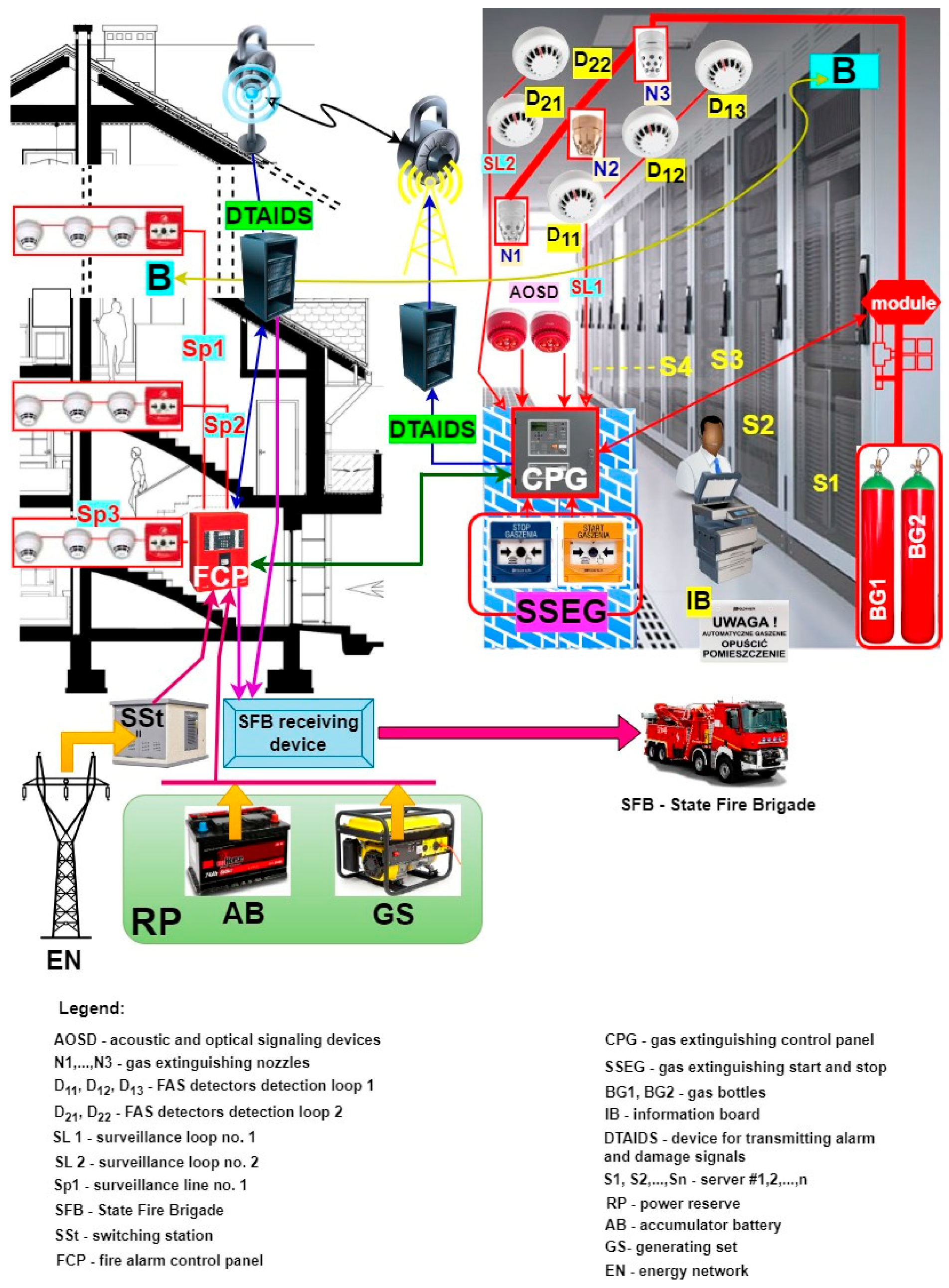
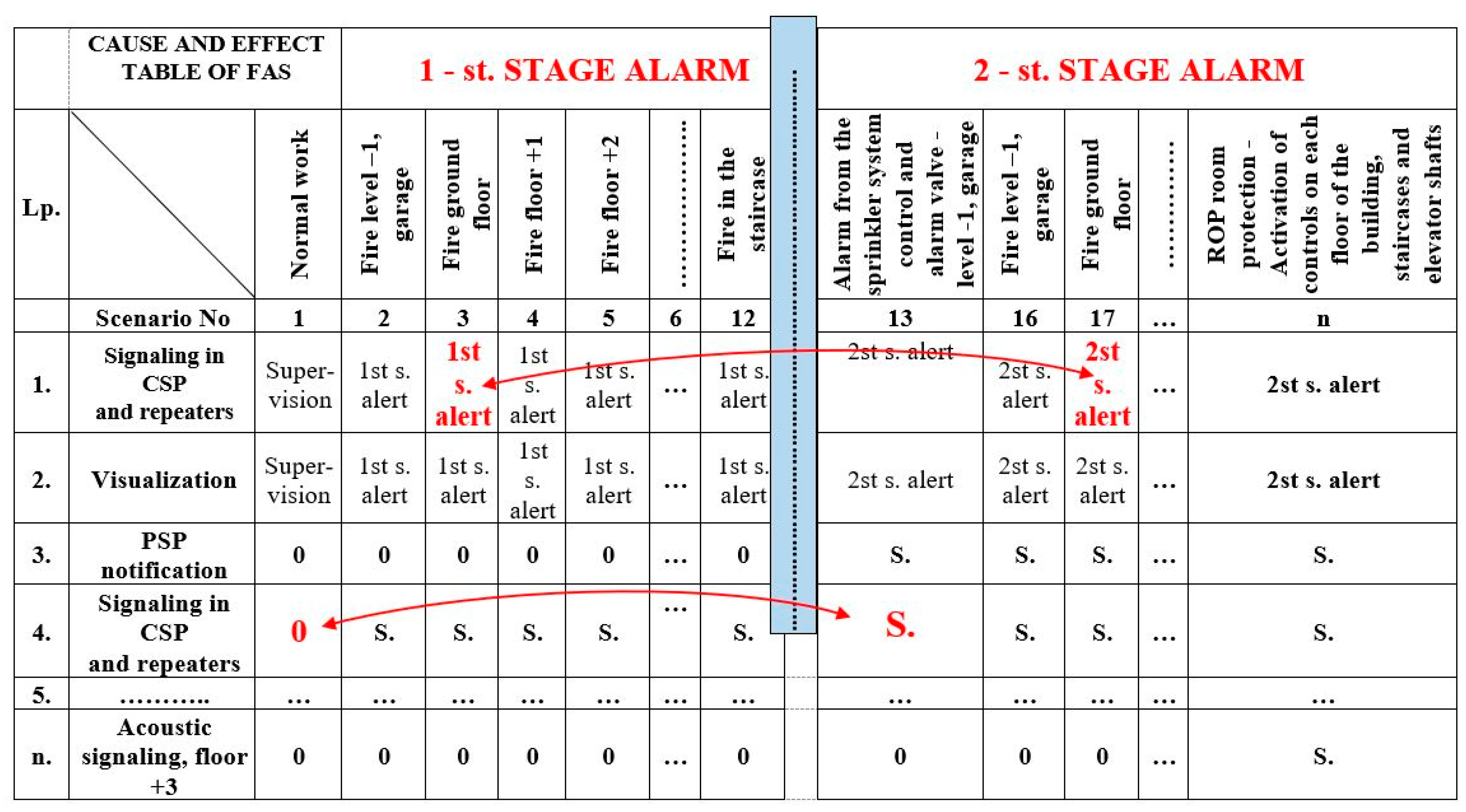
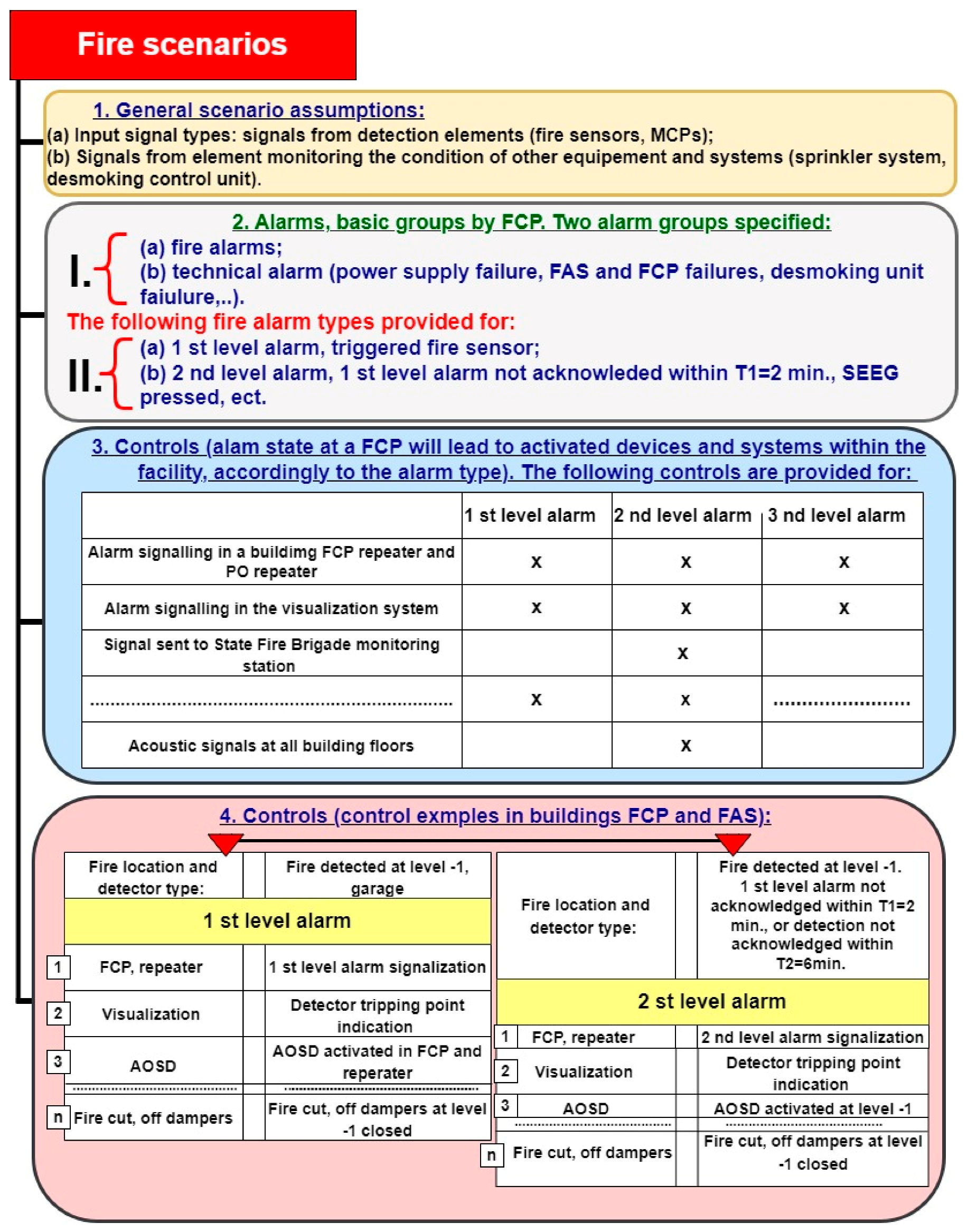

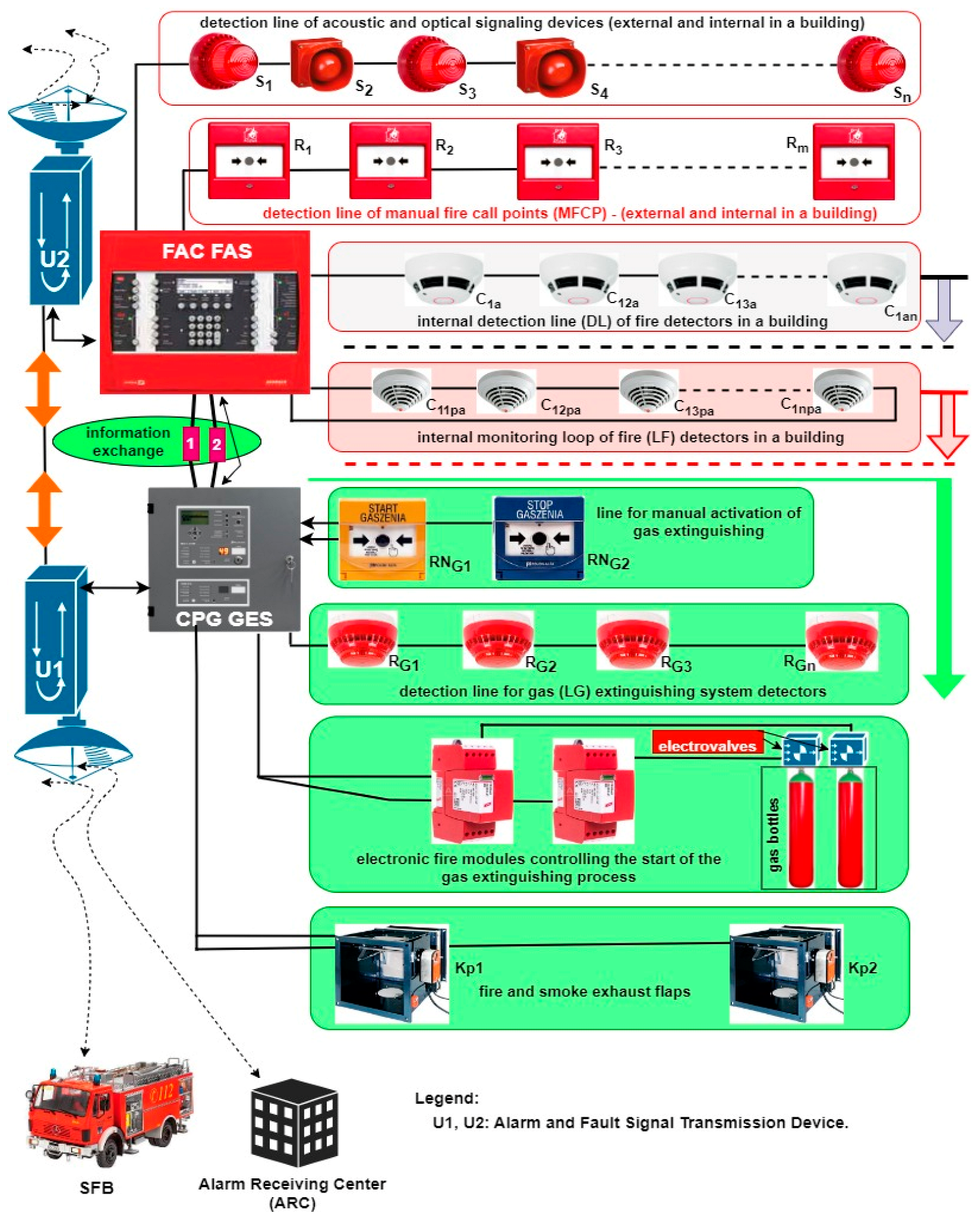


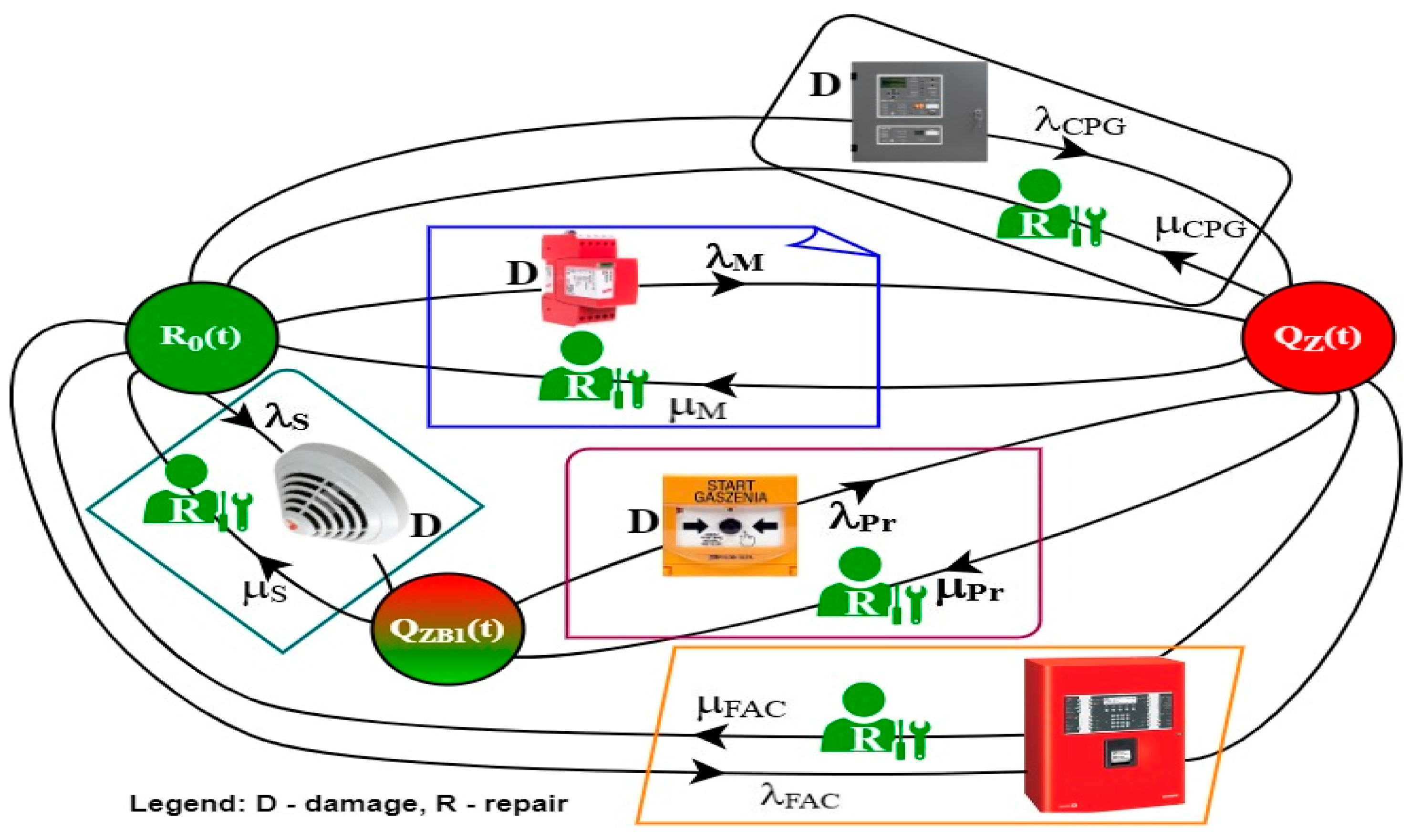
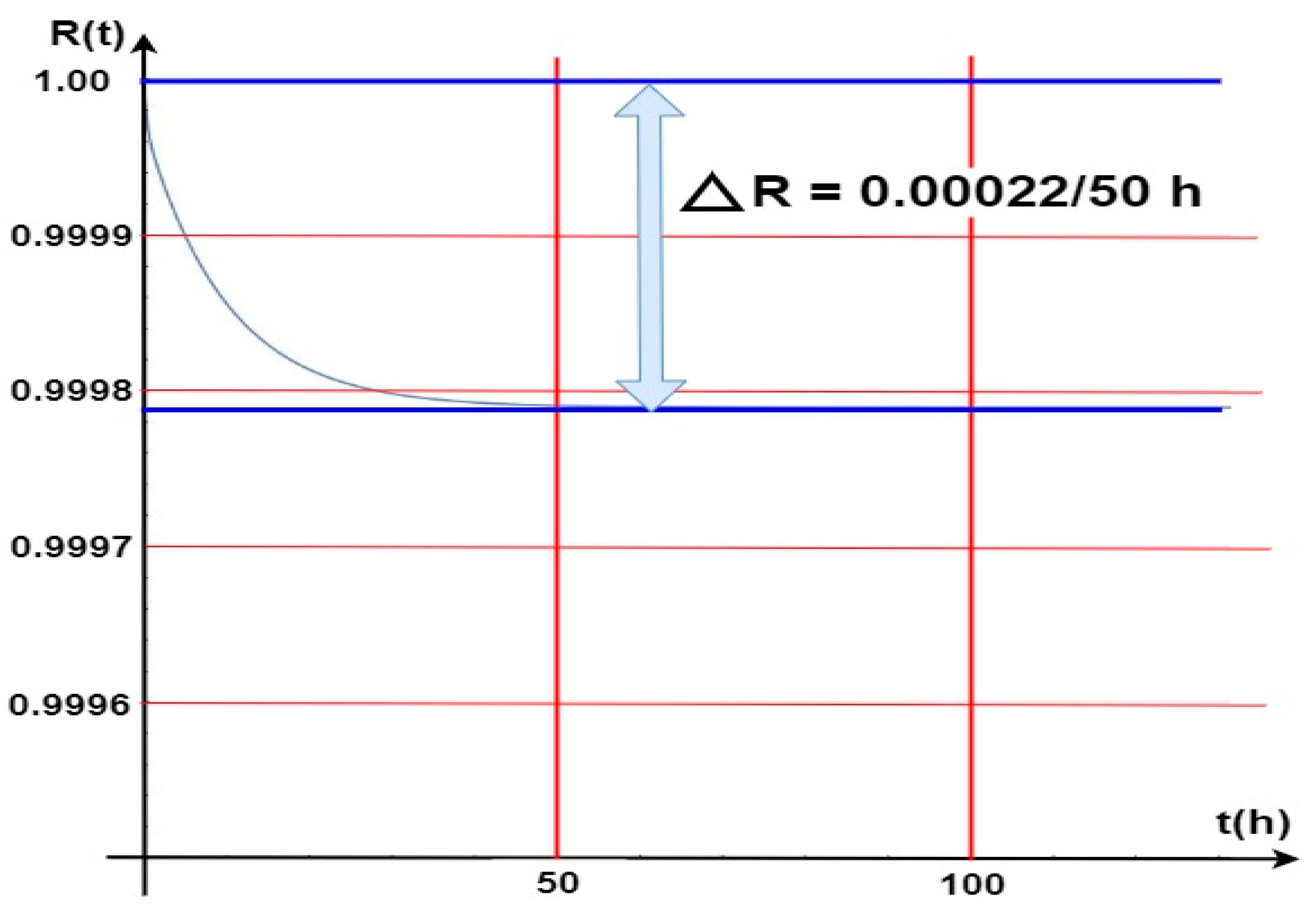
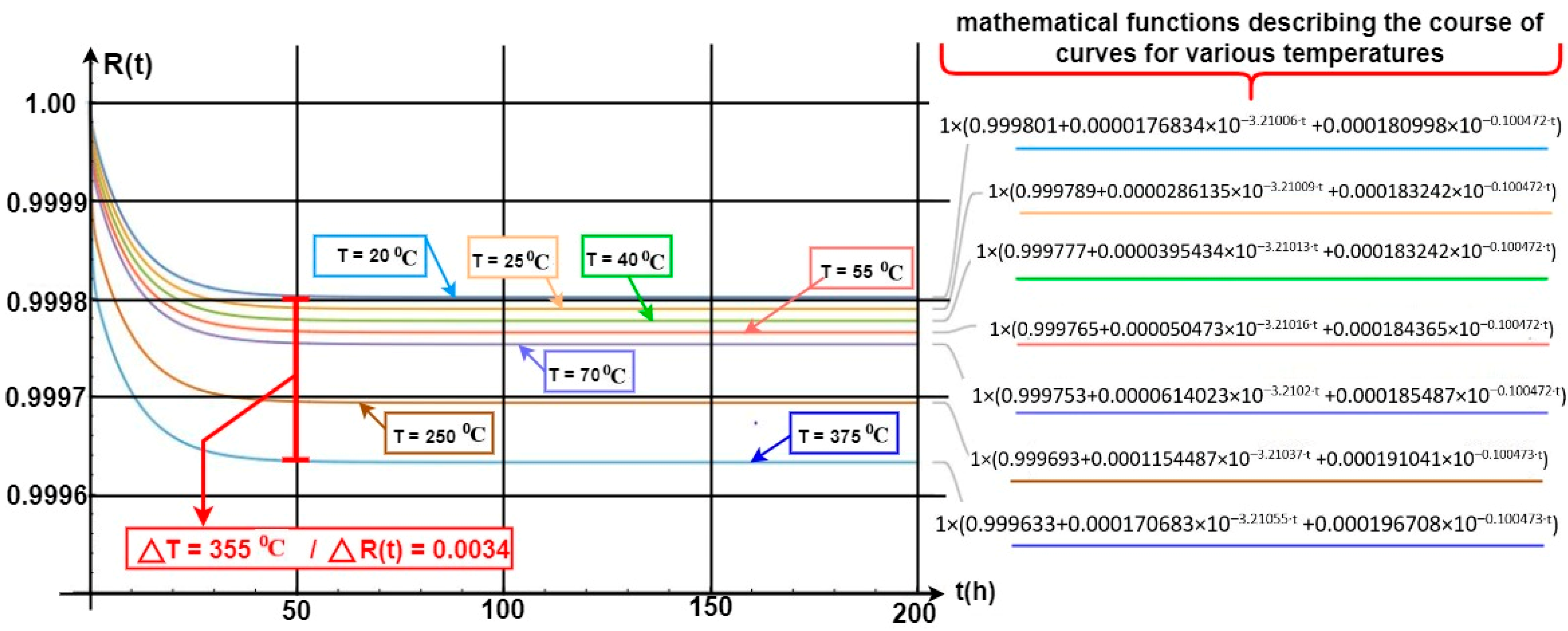

| failure intensity of gas suppression control unit λCPG | 8.85 × 10−6 | recovery intensity of gas suppression control unit μCPG | 0.5 [1/h] |
| failure intensity of fire alarm control unit λFCP | 12.9 × 10−6 | recovery intensity of fire alarm control unit μFCP | 2.5 [1/h] |
| failure intensity of module λM | 25.2 × 10−6 | recovery intensity of module μM | 0.2 [1/h] |
| failure intensity of sensor λS | 18 × 10−6 | recovery intensity of sensor μS | 0.1 [1/h] |
| failure intensity of manual extinguishing trigger button λPr | 45.5 × 10−5 | recovery intensity of manual extinguishing trigger button μPr | 0.01 [1/h] |
Disclaimer/Publisher’s Note: The statements, opinions and data contained in all publications are solely those of the individual author(s) and contributor(s) and not of MDPI and/or the editor(s). MDPI and/or the editor(s) disclaim responsibility for any injury to people or property resulting from any ideas, methods, instructions or products referred to in the content. |
© 2024 by the authors. Licensee MDPI, Basel, Switzerland. This article is an open access article distributed under the terms and conditions of the Creative Commons Attribution (CC BY) license (https://creativecommons.org/licenses/by/4.0/).
Share and Cite
Paś, J.; Klimczak, T.; Rosiński, A.; Stawowy, M.; Duer, S.; Harničárová, M. The Dynamic Change in the Reliability Function Level in a Selected Fire Alarm System during a Fire. Sensors 2024, 24, 4054. https://doi.org/10.3390/s24134054
Paś J, Klimczak T, Rosiński A, Stawowy M, Duer S, Harničárová M. The Dynamic Change in the Reliability Function Level in a Selected Fire Alarm System during a Fire. Sensors. 2024; 24(13):4054. https://doi.org/10.3390/s24134054
Chicago/Turabian StylePaś, Jacek, Tomasz Klimczak, Adam Rosiński, Marek Stawowy, Stanisław Duer, and Marta Harničárová. 2024. "The Dynamic Change in the Reliability Function Level in a Selected Fire Alarm System during a Fire" Sensors 24, no. 13: 4054. https://doi.org/10.3390/s24134054







